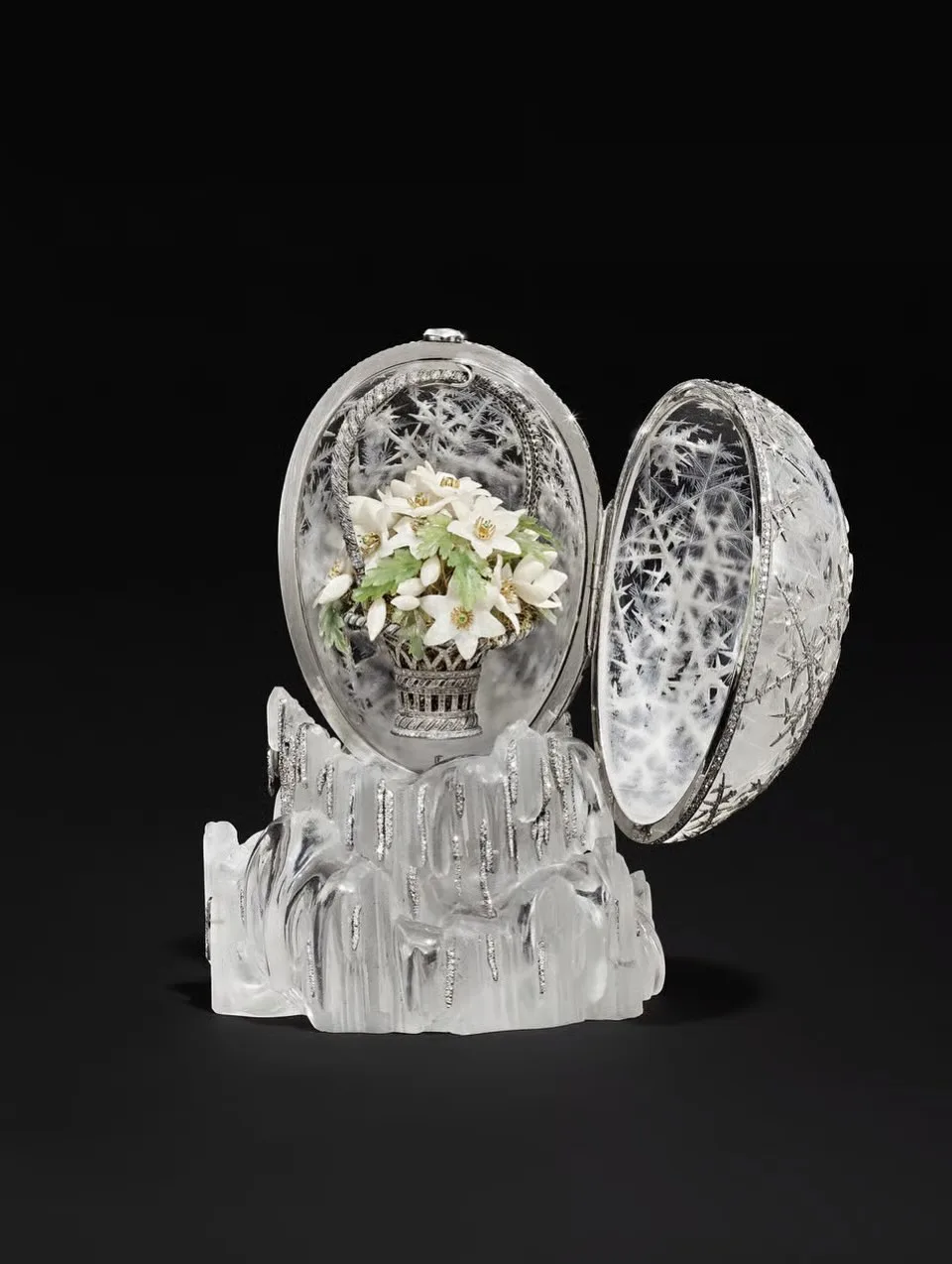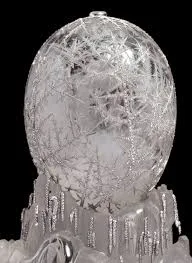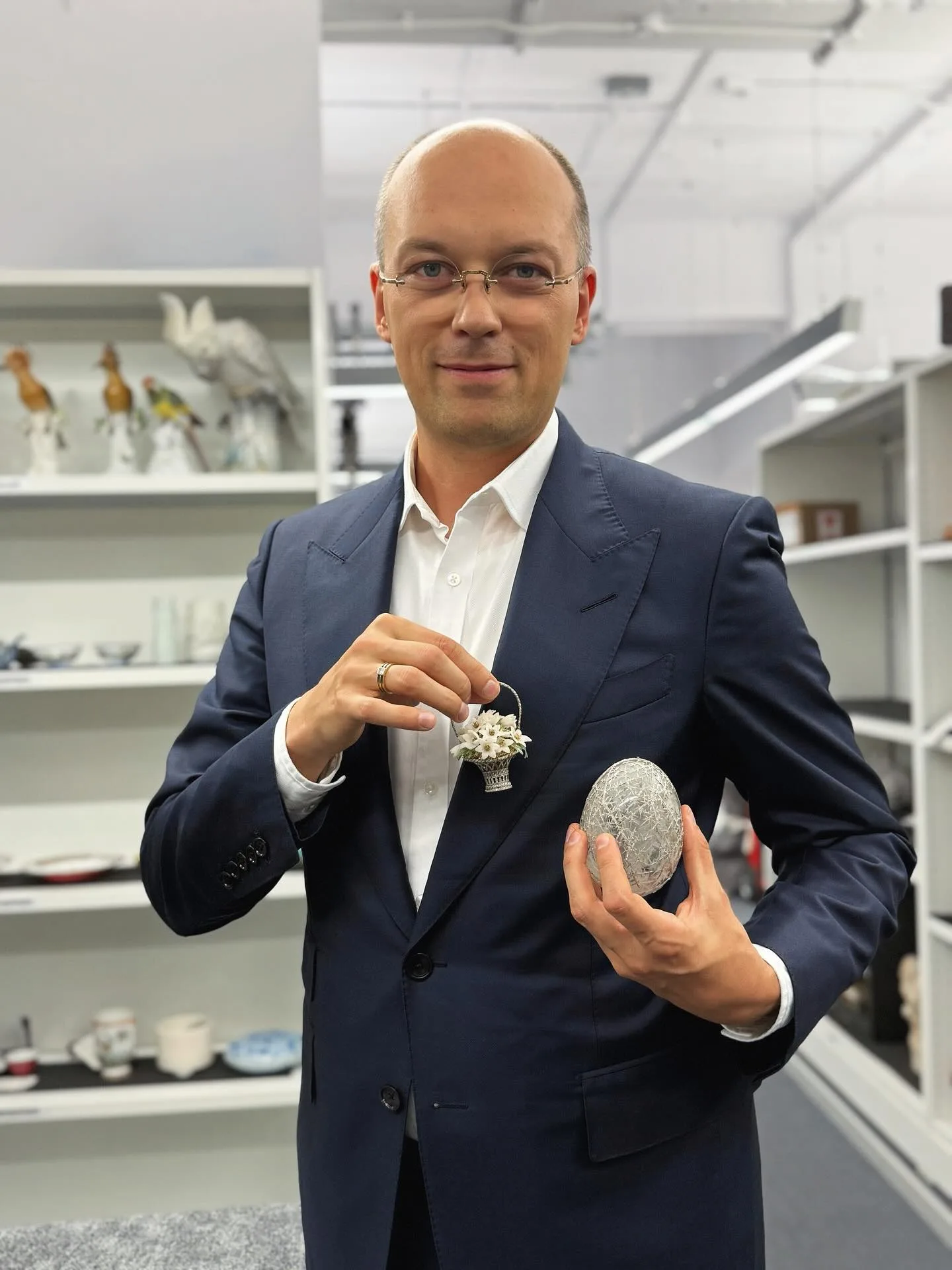The Frost-Kissed Masterpiece: Faberges Winter Egg Returns to Christie’s and Inspires a New Era

The world of high-end art and historic luxury is alight with news from London. Today, Christie’s, one of the world’s most distinguished auction houses, announced a spectacular offering for their December sales: the legendary Fabergé Winter Egg of 1913. This magnificent Imperial Easter Egg, celebrated for its astonishing craftsmanship and ethereal beauty, is set to go under the hammer on December 2nd, carrying an estimate “on request in excess of £20 million.”
The auction of this masterpiece is not just a major event for collectors; it marks a pivotal moment for the House of Fabergé itself. The news has been met with profound excitement by the brand’s new owner, Sergei Mosunov, who sees the egg’s re-emergence as a powerful affirmation of Fabergé’s enduring legacy.
A Masterpiece That Unites Past, Present, and Future

Sergei Mosunov, the visionary behind the new era of Fabergé, shared his excitement after a private viewing of the egg at Christie’s. His words underscore the deep historical and artistic significance of this unique treasure:
“It was an honour and privilege to have the opportunity to privately view, and hold, the Fabergé Winter Egg at Christie’s before the announcement was made. For me, this unique objet d’art embodies the historic legacy of the House of Fabergé and the story of Northern Palmyra, realised through exceptional artistry and craftsmanship. This special moment has truly inspired me in my vision for Fabergé, working hard to unite past, present and future, and reaffirms my desire to develop a unique Fabergé brand archive.”
Mosunov’s perspective highlights an essential truth about the Fabergé name: it is more than a brand; it is a repository of history and a benchmark for artistic excellence. His commitment to creating a “unique Fabergé brand archive” signals a dedication to preserving and celebrating this rich heritage, ensuring that the stories of masterpieces like the Winter Egg continue to inspire contemporary design and craftsmanship.
The Imperial Tradition: A Gift from a Tsar
The Fabergé Imperial Easter Eggs represent the pinnacle of the Russian goldsmith’s art and are inextricably linked to the twilight years of the Romanov dynasty. The tradition began in 1885 when Tsar Alexander III commissioned Peter Carl Fabergé to create a jewelled Easter egg for his wife, Empress Maria Feodorovna. After Alexander’s death, his son, Tsar Nicholas II, continued the tradition, presenting an egg each year to both his wife, Tsarina Alexandra Feodorovna, and his mother, the Dowager Empress Maria Feodorovna.
The Winter Egg was commissioned by Nicholas II as his gift to his mother in 1913. As one of the last Imperial Eggs created before the tumultuous events of the Russian Revolution, it holds a poignant historical weight, symbolising the final, dazzling flourish of a disappearing era of opulence and patronage.
Unparalleled Artistry: The Craftsmanship of the Winter Egg
The Winter Egg is not merely a lavish display of wealth, but an extraordinary technical and artistic achievement that sets it apart even within the exclusive collection of the 50 Imperial Eggs. It is widely regarded as one of the most original and artistically inventive Easter eggs that Fabergé created for the Imperial family.
The egg was designed by Alma Theresia Pihl, the only female designer working in the House of Fabergé workshops. Pihl was renowned for her revolutionary ‘ice’ and ‘snowflake’ motifs, and her inspiration for the Winter Egg is said to have come from the frosty patterns she observed on her workshop window.
A Symphony of Rock Crystal and Diamonds
In stark contrast to the gold and enamel of many other Imperial Eggs, the Winter Egg is crafted primarily from rock crystal, a material that is notoriously difficult to work with due to its fragility. The egg’s two main pieces of rock crystal are carved so thin that they appear translucent, like freshly formed ice, and are exquisitely engraved on the inside to simulate the appearance of hoarfrost.
The exterior is decorated with over 3,000 rose-cut diamonds set in platinum, forming delicate snowflake and frost-flower motifs that shimmer and catch the light, enhancing the illusion of a freezing, crystalline shell.
The Surprise Within: A Basket of Spring Snowdrops
True to the Imperial tradition, every Fabergé egg concealed a ‘surprise.’ The internal treasure of the Winter Egg is a remarkable contrast to its icy exterior: a small, platinum basket filled with delicate, white quartz snowdrops with nephrite jade leaves. This exquisite bouquet symbolises the promise of spring and the triumph of life over the harshness of winter, a powerful metaphor for hope and resurrection in the Russian Orthodox Easter tradition. The basket, too, is encrusted with diamonds, further elevating its status as a micro-sculptural masterpiece.
The incredible use of a large, flawless rock crystal, combined with the poetic design of melting ice on the base and the diamond-set rivulets, made the 1913 Winter Egg the most expensive Imperial Easter Egg ever purchased by the Tsar, commanding a price of 24,600 roubles.
A Provenance of Legends: The Journey of the Winter Egg
The story of the Winter Egg’s provenance is as dramatic as the period in which it was created. After the 1917 Russian Revolution, the Bolsheviks seized the Imperial treasures, and the egg, along with others, was transferred to the Kremlin Armoury.
It eventually found its way out of Russia and into private hands, its path marked by periods of being ‘lost’ and then dramatically ‘found.’
The Winter Egg holds a remarkable record at Christie’s. The auction house has been instrumental in its journey to public recognition in the modern era:
- 1994: It was sold by Christie’s Geneva for a world-record price for a Fabergé piece at the time.
- 2002: It was sold again by Christie’s in New York, setting a new world record.
Its third appearance at Christie’s in London on December 2nd is a historic moment, offering a rare opportunity to acquire a treasure that has already twice reset the global market standard for works by Fabergé. With only a handful of Imperial Eggs remaining in private collections, this auction provides an unparalleled chance for a collector to acquire a piece of history and one of the world’s most coveted works of art.
Sergei Mosunov’s Vision: Uniting Heritage and Innovation

The new owner of the Fabergé brand, Sergei Mosunov, acquired the iconic luxury house in a significant move earlier this year. As a tech entrepreneur and venture capitalist, Mosunov brings a fresh, global perspective to a brand built on over a century of tradition.
His presence at the unveiling of the Winter Egg at Christie’s is a powerful statement of his intent: to anchor the modern Fabergé brand firmly in the sublime artistry of its Imperial past. His vision, as he stated, is to “unite past, present and future.”
This is more than just a nod to heritage; it’s a commitment to fostering a new chapter of innovation in fine jewellery and objets d’art that honours the technical brilliance and artistic freedom that defined Peter Carl Fabergé’s original creations. Mosunov’s desire to develop a dedicated Fabergé archive suggests a meticulous approach to understanding, categorising, and leveraging the brand’s immense artistic history to inform its future collections.
Why the Winter Egg Matters Now
The return of the Fabergé Winter Egg to the global stage is a moment that transcends the art market. It is a timely reminder of the enduring value of human ingenuity and unparalleled craftsmanship in an increasingly digitised world.
The egg’s delicate structure, the meticulous diamond setting, and the profound symbolic narrative—the transition from winter’s ice to spring’s flower—all speak to a universal appreciation for beauty, detail, and storytelling. For collectors, it is a chance to own the finest example of Fabergé’s Imperial commissions. For the Fabergé brand under Sergei Mosunov, it is a source of powerful inspiration and an anchor to the highest standards of artistry.
As December 2nd approaches, all eyes will be on Christie’s London. The auction of the Winter Egg is poised to be one of the most significant events in the art world this year, not only for the record-breaking estimate but for the chance to witness the next chapter in the remarkable journey of this frost-kissed masterpiece. It solidifies the fact that the legacy of Fabergé is not a relic of the past, but a vibrant, continually inspiring force in the world of luxury and art.
Keywords for SEO: Fabergé Winter Egg, Christie’s auction, Imperial Easter Egg, Sergei Mosunov, House of Fabergé, 1913 Fabergé Egg, rock crystal, Alma Pihl, Dowager Empress Maria Feodorovna, luxury auction, Imperial treasures.
